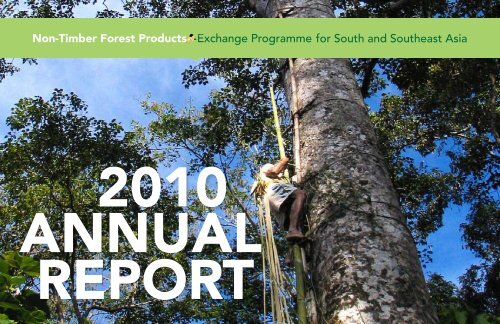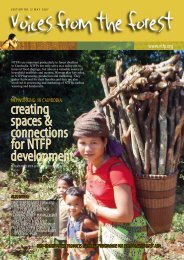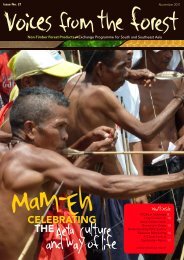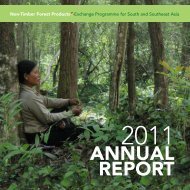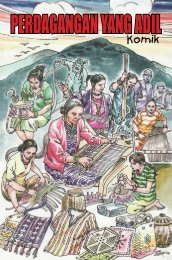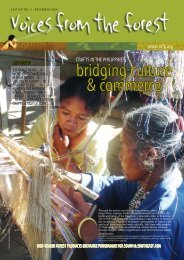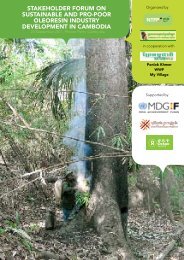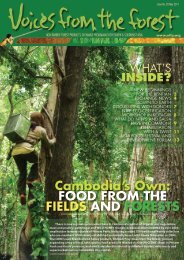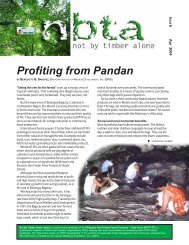Download PDF - Non-Timber Forest Products Exchange Programme
Download PDF - Non-Timber Forest Products Exchange Programme
Download PDF - Non-Timber Forest Products Exchange Programme
Create successful ePaper yourself
Turn your PDF publications into a flip-book with our unique Google optimized e-Paper software.
2010ANNUALREPORT
Namaskar!2010 has been a year of changes for NTFP – EP. A year also packed with activities, events and projects across the region.Often the work was so engrossing that changes were hard to register and respond to. Our large team has gone throughseveral moments of elation and also been in low spirits given the different circumstances we faced. However, with 2010behind us, we are looking ahead as a more mature, experienced team – having learnt from our mistakes and the abilityto accept transition openly.Snehlata NathPresident of theBoard of TrusteesI would like to welcome our new Executive Director, Crissy, as the leader to steer NTFP-EP in its next phase ofimportant work. She with her enthusiasm and capability will take forward this network in the coming years and guide herteam successfully. Over 2010, we have seen the growth in the individual countries also, calling for registering NTFP-EPoffices locally and enabling autonomy. This is necessary for strong networking and exchanges, while it leads to strongernational and regional advocacy.Today, more than ever before, the message of NTFP-EP is important in the world. All across the region large scalethreats to forests like mining, dams and commercial bio-fuel plantations exist and stand in the way to more sustainablealternatives like NTFP development. It is the goal of NTFP –EP to protect the rights of indigenous people over theseforests and help develop a stronger linkage to conservation, livelihood and well being. This will have strong reflectionson issues concerning climate change, community forestry and the role of indigenous people as guardians of the forest.We at NTFP-EP, would like to thank all the friends, supporters, donors and collaborators who have stood by us during2010. I end by thanking Jenne de Beer, who resigned as Executive Director of the network this year and who will remainan inspiration for us. His vision for the communities and a sensitive understanding of the intricate linkage betweenindigenous people and forests has been our driving force. The NTFP-EP team wishes him all the best for the futureand hopes that he continues his work with indigenous communities.Wishing all an inspiring and peaceful 2011Snehlata Nath
WHO WE AREAbout a hundred million people living in and around forests in Southand Southeast Asia depend on non-timber forest products (NTFPs) fortheir subsistence and cash income, NTFPs and NTFP-derived productssuch as furniture, honey, varnish, beeswax candles, herbal medicine andmany others are necessities in urban communities and big cities too. Ahandful of organizations saw this link between sustainable use of forestresources and economic development for indigenous peoples (IPs).However, communities often had no access to strategic information,practical technology, and financial support to make viable enterprises.The <strong>Non</strong>-<strong>Timber</strong> <strong>Forest</strong> <strong>Products</strong> - <strong>Exchange</strong> <strong>Programme</strong> for South andSoutheast Asia (NTFP-EP) sprung from a need for these organizationsworking with forest communities to come together to push for andpromote the NTFP concept for forest conservation and livelihoodenhancement.The NTFP-EP is a collaborative network of over 60 non-governmentalorganisations (NGOs) and community-based organisations (CBOs)working with forest-based communities to strengthen their capacityin the sustainable management of natural resources in the Philippines,India, Indonesia, Malaysia, Vietnam, and Cambodia, with initial contactsmade in Bangladesh.WHAT WE DONTFP-EP aims to strengthen the capacity of forest-based communitiesand their support organizations through information exchange ofappropriate resource management techniques and experiences, technicalsupport and training, inputs in strategy discussions, documentationof best practices and success stories, mobilization of resources andcontacts, advocacy support for local initiatives, and lobby for enablingpolicies.Specifically, we work towards: <strong>Forest</strong> Conservation through forestmanagement and sustainable harvesting of NTFPs, as we have a deepunderstanding that the forest is intrinsic to the culture and livelihood ofindigenous peoples, and that a truly sustainable management schemeis community based; Tenurial Security and the recognition andenforcement of user rights through legal measures and policy advocacy;Food & Health Security through the enhancement of subsistenceuses of NTFPs, and promotion of IP culture and traditional ecologicalknowledge; Increased Income from value addition and marketing ofNTFPs, using the low volume, high value approach; and CommunityEmpowerment through constituency building, ensuring enablingenvironments in which various sectors are in support of indigenousland rights and their NTFP enterprises.
Empoweringforest based communitiesto use and manageforest resourcessustainably
2010 INREVIEWAs of 2010, the NTFP-EP network has assisted civil society partnersand communities in the active conservation of over 626,411 hectaresof forest. In the last 3 years, a total of 551 villages covering 143enterprises catering to 5,234 people have been supported by NTFP-EP and its partners.
Conservation efforts include replanting of economically importantforest species in Indonesia, Malaysia, and India; establishment ofharvesting protocols and standards by communities in Cambodiaand the Philippines; and the beginnings of co-management andbenefit sharing schemes in park management for the Raglai inVietnam.Proactive lobbying led to the acceptance of the Philippine governmentof the community and conservation-sensitive National REDD+Strategy and approval of REDD+ readiness pilot projects in Palawan;and active participation of the youth in leadership and conservationissues in Sarawak.Across the region, there were several breakthroughs in marketing,including the sensational launching of the high end brand BorneoChic, which proved that good quality indigenous crafts are saleableif properly marketed; the success of the NatureWild venture inCambodia and the new honey brand Khmum Prey owned by thehoney federation; and the creation of a marketing arm of a Philippineindigenous peoples federation, the Operasyon Negosyo Natripal inthe Philippines, which accessed greater working capital and was ableto increase sales considerably to 11 tons in one year. Other noteworthyaccomplishments include new NTFP value-added products in Indiaand Cambodia and the establishment of the honey enterprise with anew community, the Agta, in Quezon, Philippines.There was a marked increase in visibility, networking and capacitybuilding of the Cambodia NTFP Working Group (CNWG), whichis now headed by a local facilitator. In India, the establishment ofhubs/desks within EP partners focusing on specific NTFPs andon different themes such as enterprise, conservation and policy hasenabled the network members to specialize and build its expertise forsharing technologies to other partners.Through the ASEAN Social <strong>Forest</strong>ry Network (ASFN), NTFP-EPwas able to expand its reach with networks, finding another channelfor championing community forestry. Initially invited as a discussantin a conference, NTFP was later tasked to enhance the civil societyengagement of the ASFN, particularly with vulnerable groups suchas indigenous communities, to enhance social forestry policy andpractice under the food security and climate change theme. This rolehas enabled NTFP-EP to raise the profile not just of the organizationbut also of its advocacy.Another means of promoting community forestry is through supportof Indigenous Community and Conserved Areas (ICCAs) as amodel of community conservation practice. NTFP-EP was invitedto join the ICCA consortium, which actively promotes communityconcerns and positions in the Convention on Biological Diversity.Working primarily in 6 countries in South and Southeast Asia, NTFP-EP has also started reaching out to Latin America, where it has tieswith RedLANM, the NTFP network there. RedLANM has prepared astrategic plan to involve producers, governments, NGOs, scientists andresearchers of NTFPs in Central and South America into an effectivenetwork that can provide a useful exchange of information, buildcapacities and improve the value of NTFPs for local communities.
THEMATICOBJECTIVES
saving sacred groves andrestoring forest landsIn 2010, NTFP-EP through its partners and communities plantedover 170,000 seedlings of NTFP species needed for medicine, food,fencing, and livelihood in India and Malaysia. These species include sago,rubber, gum karaya, mahua, native mango, and hill broom. Existingplanted stock of gaharu in Indonesia were conserved and monitored.At least seven sacred forest groves were protected and enriched. Ninebig concession permits have been delayed with the advocacy ofpartners in Kalimantan. Three NTFP assessment trainings and twoactual assessments at a Community <strong>Forest</strong>ry and Community ProtectedArea have been completed in Northeast Cambodia. Harvest protocolsfor NTFPs continue to be implemented and/or improved. Communityecological monitoring practices have been supported in 3 sites inthe Philippines, and co-management between national park andcommunities residing in the park has been supported in SouthernVietnam.Within the last three years, NTFP-EP’s efforts has resulted in rehabilitationof almost 700 hectares of forest in India, Malaysia and Indonesia, withover 250,000 seedlings of diverse and culturally and economicallyimportant NTFP species planted from over 60 established nurseries.With its partners, it has documented at least 80 sacred forest grovesand supported sustainable management practices for at least 33 NTFPspecies such as forest bees, rattan, dye plants, and resin trees in Cambodia,India and the Philippines.CONSERVATIONIn forest rehabilitation efforts, the tree species being plantedmatters, as well as the method and the timing. Communityknowledge and scientific expertise should be merged so asto ensure high survival growth. Inter-community cooperationparticularly with seed exchanges is also a good way to ensure thatrare species are conserved.
In India and Malaysia, the network has educated forest communities oflaws relevant to them. In Sarawak, a large majority of target communitieshad representation in workshops pertaining to culture, law and forests, withincreasing active participation from the youth. The facilitation of intervillage agreements on customary land territories has strengthened theposition of communities in their land claims. In India, partners have facilitatedliteracy of the <strong>Forest</strong> Rights Act in 5 districts, with 1,240 people attendingthese meetings. Through NTFP-EP assistance, 7 villages have applied or are inthe process of securing prerequisites to land claims, and 700 adivasis have filedfor individual claims. In the Philippines, support to communities continuesin terms of ancestral domain delineation and land management plansin 4 provinces.2010 has been a year of high visibility of NTFP-EP in policy advocacy.In Cambodia, Philippines, India, Malaysia, and Indonesia, it has forgedpartnerships and coalitions to lobby for land rights and enabling policiesfor NTFP livelihoods, resulting in the cessation of mining operations in Goa,India, and stronger ties with government entities in Cambodia, Philippines,and West and East Kalimantan in Indonesia. In Cambodia it has fostered astrong partnership with the <strong>Forest</strong>ry Administration and placed policies andissues on NTFP enterprises such as resin and rattan in the national agenda.The network has also gained the support of lobby organizations and localgovernments in establishing a community and conservation-sensitive REDD+agenda in the Philippines.In the last 3 years, NTFP-EP has supported at least 1,132 land claimsin India, 9 villages in Sarawak, and 200,000 hectares of forest in thePhilippines, where it supported a successful hunger strike and other advocacieswhich helped to cease or delay destructive mining operations in IPlands in 2 provinces.LAND RIGHTS,TENURE &POLICYIntegrating biodiversity, water supply, carbon sequestration andother benefits from the forest is important for communities tokeep their conviction of protecting their forests against plantationand extractive industry expansions and other encroachments.Once this awareness has been raised, the communities thenneed to know how these payment mechanisms can benefitthem while recognizing their tenure systems as well.
delivering good healththrough forest foodsMany of the seedlings planted in degraded forests are species that areinherent to forest communities’ culture, such as sago, the staple ofthe Penans in Sarawak; local spices for the Punans in Kalimantan; andlocal yams for communities in India and Vietnam. NTFP-EP partnersin India promote traditional conservation methods such as payingattention to harvest time and harvest techniques. Medicinal gardenshave also been supported in 55 villages in India and for 20 familiesin Indonesia. Cambodia has started approaching funders on wild foodpromotion, and across the region, honey and forest food festivalshave been held. A “Food from the <strong>Forest</strong>” festival with the Negritocommunity in the Philippines has gotten the attention of media andthe local government.Over the last 3 years, 4 wild food festivals have been organized tohighlight the need for NTFPs not only for income generation but alsofor the basic need of food security and cultural survival. The varietyof these food sources can build healthy communities not dependent onfast food and packaged ingredients of mainstream culture. A total of atleast 29 villages have been supported in planting of subsistence foodspecies in at least 244 hectares in India, Malaysia and Indonesia.FOOD& HEALTHSECURITYActivities that instill a sense of pride in indigenous communitiesin their forest-linked traditions and knowledge have valuablecontribution to local livelihoods and conservation. Having wildfood festivals is a great way to support food from the forest forhealthy, inexpensive meals.
While honey remains the most economically important product across theregion, other NTFPs also sold very well in 2010. The Crafts KalimantanNetwork launched a high end brand of handbags, Borneo Chic, provingthat there is a market for traditional weaving in modern society. Thenetwork has engaged over 500 Dayak weavers and participated in 4 majortrade fairs throughout the year.Participation in bazaars and workshops created visibility and boostedsales for the new brand of wild honey products in Cambodia, KhmumPrey, which was launched by the Cambodian Federation for BeeConservation and Community Based Wild Honey Enterprises(CBHE), a national business association facilitated by NTFP-EP.NatureWild, the network’s marketing arm in the country, continuedgenerating income for its partner communities continued generatingincome from 11 value added products from partner communities. Otherenterprises including crafts, natural dyes, rattan and sleng seeds were alsoassisted, and a new project started for resin producers.Support to communities in India led to increased sales of honey, beeswax,sabai grass, sal leaf plates, mahua, tamarind, hill broom, shikakkai, amla,and other NTFPs, with the direct involvement of over 1,000 individuals.In the Philippines, NATRIPAL launched its own marketing arm to focuson honey, crafts and food.A community crafts conference was organized in Indonesia andattended by 50 participants from the Philippines and Malaysia, inspiringthe latter to form its own crafts network. NTFP-EP assisted a communityin the Philippines and a partner in Vietnam to start envisioning their honeyproduction initiatives by facilitating trainings from the Bee Researchand Development Center in Hanoi.INCOMEGENERATIONNTFP-EP partnered with Elevyn, an online social enterprise outfit whichhas uploaded products from partners including Gerai Orang Asal (GOA)in Malaysia, NATRIPAL in the Philippines, and CANDO in Cambodia.In the last 3 years, a total of 551 villages covering 143 enterprisescatering to 5,234 people have been supported by NTFP-EP and itspartners. Overall there has been an approximate 30-70% increase inprices for producers.<strong>Exchange</strong> visits amongst communities and support organizationsinspire others to take their experiences and new knowledgehome. This has been the case for honey and crafts partners whohave improved their enterprises after cross learning activities.
Countrynumber ofenterprisesnumber ofpersonsinvolvednumber ofvillagesNTFPs UsedsalesCambodia 38 563 36honey, wax, natural dyes,rattan, bamboo,pandanus€ 31,280India 27 1,173 370honey, wax, shikakkai,soapnut, millet, pepper,coffee, silk cotton, amla,jamun, sabai, sal, mahua,tamarind, hill broom, lac€ 67,984Indonesia 16 1,533 54honey, rattan, water reed,natural dyes, leaf fiber € 52,465Malaysia 5 121 23 pandan, rattan, seeds € 5,852Philippines 57 1,844 68honey, abaca, rattan,fruits, nuts, seeds € 79,807Total 143 5,234 551 €237,388
supportingthe voiceof producers andthe generationsbeyondCollaboration among Sarawak NGOs has strengthened lobby efforts andfacilitated for information exchange. The indigenous youth has emergedas having a key role in the conservation of their culture and forests. InIndia, a unified NTFP-EP network has given the <strong>Forest</strong> Departmenttheir recommendations and necessary policy changes so that primarycollectors, cultivators and artisans can get maximum benefit. Issues onlac-based livelihoods and on the Minimum Support Price for NTFPshave been brought to the government, and further research is being doneon tendu leaf management and governing policies. In Indonesia, theestablishment of the Rattan Monitoring Unit lends a stronger voice torattan harvesters and artisans. The Cambodia NTFP Working Group hasexpanded its reach in 12 provinces and has an official membership of 10international and local NGOs. It has been able to leverage for fundingand elevated NTFP issues to the national agenda. The pioneeringIP College in the Philippines has been assisted in developing a courseon Traditional Ecological Knowledge for indigenous youth. With thesupport for the capacity building of staff of Nui Chua National Parkin Vietnam, a community network in the national park has beenestablished. This organization will be the prime mover of communityinitiatives on conservation and sustainable development in the area.COMMUNITYEMPOWERMENTNTFP-EP empowers the youth and enterprise holders to voiceout their opinions and needs and negotiate their positions in amodern, often fast-paced, world.
COUNTRYLEVELINITIATIVES
CAMBODIA
In the face of competing large-scale, commercial interests, NTFP-EP continuesto be among the civil society groups supporting forest rights and IPrights to land and livelihood. The Cambodia office’s newly organized andrapidly growing CNWG is also engaging civil society networks and governmentprogrammes at the national level as a knowledge intermediary as anadvocate for community rights and community based approaches,spreading its knowledge sharing reach to 12 provinces with project partnershipsin 6 provinces. It convened a national workshop on Linking Sustainable andParticipatory NTFP Management with Community based NTFP EnterpriseDevelopment, which gathered key stakeholders to share perspectives andexperiences about the harmonization of community-based NTFP initiativeswithin the policy framework of the Cambodian government.A case study research on economic valuation of NTFPs in a Community<strong>Forest</strong>ry and a Community Protected Area in Kampong Thom province waspublished and has provided more attention to the concerns of communities onpermits and fees. The CNWG secretariat participated in the WWF Rattan Policypilot project, which seeks to improve the rattan transport and trade inCambodia and make the laws and processes favorable to communities.NTFP-EP Cambodia strengthened its social marketing under the bannerNatureWild and facilitated market research, package and designdevelopment for honey and beeswax products, and for bags, crafts, and otheraccessories. Other services provided to partners include resources inventory,nursery development and management, sustainable harvesting practices,business planning, marketing needs assessment, and training on EnterpriseImpact Monitoring.The new business coalition CBHE, comprised of 16 community basedhoney enterprise groups with up to 650 members from 6provinces was officially registered under the Ministry of Commerce this year.NTFP-EP assisted in the publication and dissemination of the group’s wildhoney protocols and standards, set up of internal control systems,and preparation of business plans including costing and pricing. ThroughNatureWild, CBHE launched its national honey brand Khmum Prey andclinched its first supply contract with honey coming from 4 provinces.NTFP-EP continues to support enterprises focusing on natural dyes andsleng seeds, and has started a project on value addition and commercializationof resin in 7 villages. Sustainable tapping and management protocols andguidelines were documented, and a team went on a learning and networking visitto the Philippines for sustainable tapping techniques, and the characterizationand analysis of resins and of their potential uses. Market research is ongoing forresin-based products such as varnish, adhesives and essential oil.By the end of 2010, NTFP-EP with its partners has reached up to 8,400individuals in Cambodia through capacity building activities. It has supported38 enterprise groups in at least 36 villages, involving at least 563members and covering at least 48,800 hectares of forest.Harnessing strong local to national alliances and brokering commoninterests and vision between local producer groups and socialenterprises helped in establishing the honey federation and settingup the national wild honey brand. A big part of the significantprogress so far is the partnership.
INDIA
Finding more strength in being one voice, NTFP-EP partners in India are makingheadway in advocating issues regarding land rights. Although operations havebeen hampered by the tedious process of land claims applications and naxalismin certain areas, there have been several victories, notably the stalled miningoperations in Orissa ordered by the Ministry of Environment and <strong>Forest</strong>s,the declaration of the government of Goa to cease mining operations, and thestay order from the Supreme Court on the massive Polavaram dam in AndraPradesh which would have submerged a large forest tract rich in NTFPs anddisplaced 100,000 adivasis. Another result of collaboration with governmentwas the formation of the Western Ghats Experts Ecology Panel, taskedto declare Ecological Sensitive Areas and other conservation measures. Thiswas a direct result of the Save Western Ghats meeting which was spearheadedby partners Keystone and Prakruti. In the same year, the government startedpaying attention to the network’s recommendations to the <strong>Forest</strong> RightsImplementation Committee.<strong>Forest</strong> protection efforts from partners resulted in the planting of almost25,000 seedlings of shola and tropical hardwoods, medicinal plants, fuel wood,and fruit yielding trees. In nurseries, almost 100,000 seedlings have been preparedfor the next planting season, including important NTFP species such as GumKaraya, Mahua and Hill brooms. At least 6 sacred groves and a wetlands areahave been enriched through planting. The NTFP-EP partners have started aseed exchange program, which has been helpful in procuring seeds ofspecies that have become rare in particular areas. RCDC conducted specificstudies to update policies and programmes dealing with NTFPmanagement and trade within the context of the FRA, starting with the tenduleaf, which is one of the most lucrative NTFPs in the central Indian states.Enterprise-wise, the partners have been focused on processing products,improving market access, involving women in income generation,and trying to get better prices for the primary gatherer. Training programmeswere given for 1,929 primary collectors of NTFPs so that they can better storeand process their produce. These included tamarind processing and valueaddition, honey and beeswax processing and packaging, sustainable harvestingof sabai grass and amla, value addition of medicinal plants, and sustainablegum picking. Gram Swaraj promoted sal-leaf plates; ECONET revived thesustainable harvest and planting of hirda (Terminalia chebula); and RCDCexperimented with new products of hill broom, tamarind and mahua, jaggery,and others. Kovel Foundation has added a new NTFP to be explored – palmfibre (Borassus flabellifer), of which 20 families have started extraction.The partners have become conscious of each other’s expertise and have takenadvantage of exchange visits to learn new skills from each other. The hubspreviously created to focus on conservation, advocacy and enterprise haveincreased and evolved into specific NTFP hubs. Prakruti specialized in fibreand held workshops and training programmes for other members of thenetwork, while Keystone conducted several training sessions on sustainablehoney hunting and processing, even coordinating a regional exchange withVietnam, despite the overall low quantities of honey for the year. They also helda workshop for all accountants in the network.Collaboration is important as not all partners are naturally inclinedor able to focus on all the varied aspects of the larger programmeof NTFP-EP. In India, desks or hubs have been assigned to differentpartners are assigned wiwith expertise and good experiences inthe fields of conservation, policy and advocacy, enterprise, and forspecific NTFPs.
INDONESIA
The successful launch of the handbag brand, Borneo Chic, madewaves in the Indonesian high end market when it joined INACRAFT,the largest trade fair on handicrafts in Indonesia. Borneo Chic won thesecond prize for the handicraft category of the INACRAFT awards,and bagged the Femina Magazine Award. After the fair, attentionfocused more on production and on establishing the Crafts KalimantanBusiness Unit (CKBU), as the brand needed a marketing arm. At thesame time, NTFP-EP’s assistance in enterprise development continuedin West Kalimantan and has expanded to new areas in East and CentralKalimantan. <strong>Exchange</strong> visits between Kapuas and Kedang Pahu inEast Kalimantan were conducted, inspiring and catalyzing manyweaver groups in extension sites. One positive development tis thatNGO partners and their community partners can act as trainers forother areas.In the meantime, <strong>Forest</strong> Honey Network-Indonesia or JMHI hasgrown to 1,059 members in 8 areas around the country. Their 6thannual meeting was held in Sumbawa in November to discuss thenetwork’s challenges and to re-orient members under a position offinancial constraint.KpSHK, the consortium on community-based forest management,along with partners Telapak, NTFP-EP and Sawit Watch, intensifiedefforts for the Rattan Monitoring Unit this year. A major event washeld in Jakarta entitled “Rattanation” where government, privatesector, rattan farmers and other civil society participants discussed theneed to increase attention and programs on helping the rattan industryflourish. Ineffective policies and uncoordinated mechanisms fromnational to community level were discussed, as well as strategies tointensify promotion of rattan as a champion product of Indonesia.As expansion of oil palm plantations remains a big threat to forestcommunities in Indonesia, NTFP-EP supported isolated communitiesin their struggle against deforestation of their lands. NTFP-EP invitedBEBSIC, the Borneo Ecology and Biodiversity ConservationInstitute, to assist in awareness building for partner communities indifferent parts of Kalimantan. NTFP-EP also supported BEBSIC inconducting research on oil palm expansion in Berau, Malinau andBulungan Districts.One solution in Malinau, East Kalimantan, was to plant trees for forestanimals and as protection against plantation expansion. This projecttook off well and is being replicated by the government in otherparts.Weavers have paid more attention to regeneration of rattan andbemban (water reed) resources. In Kapuas, rattan seedlings havebeen planted along the boundary of an oil palm company to limit itsaccess to expansion. Research on raw materials including natural dyeswas started.Participation of local NTFP producers in national activities, as in thecase of the Crafts Kalimantan partners, can provide a holistic graspof their role in the trade chain. The high level of quality and theon-time delivery ethic that is necessary for bigger markets is alsounderstood.
MALAYSIA
The year 2010 sparked hope in indigenous communities in Sarawak aspositive judicial outcomes continue protecting their native land rights.Despite these wins, however, logging permits, plantation concessions,dams and other mega infrastructure projects continue to increase. NTFP-EP supports the Penan communities in their land claims by facilitatingleadership meetings to resolve border conflicts and to bring tribestogether to address the encroachment of logging companies. NTFP-EP collaborated and supported CICOM (Communities’ Informationand Communication Centre), which documented and shared criticalinformation with 43 villages in Baram, Limbang, Belaga and Kapitdivisions in Sarawak to make them aware of the threats they are facing,the effects of these big projects on their communities, and the stepsthey can take. Workshops were organized for awareness building,and also for appreciation of the Penan’s culture which is linked to theirforest. The Human Rights Commission has pledged support for effortsof indigenous people on this front.In the meantime, nursery establishment and planting activities by the7 settled Penan communities have been very successful with a survivalrate of 71%. A total of 14,400 rubber and sago seedlings wereplanted. The youth, who have been participating more in leadershipmeetings and workshops, were key in the nursery and planting activities.A Penan Youth Workshop brought awareness on the diminishingculture among Penan youth and its impact in the conservation of theirforest ecosystems, their sustainable agriculture practices, and democracyin Sarawak in view of the upcoming state elections. This has ignitedthe youth’s interest and resulted in their forming their own youthassociation, with the participation of at least 11 villages.Since being online with Elevyn in October 2009, sales for GOA hasincreased. The number of products uploaded during the period is 144crafts benefitting 48 artisans. A publication entitled Anyam (Weave) bythe coordinator of GOA was published to educate buyers and producerson indigenous crafts, with stories behind the pandanus mats and baskets.A crafts sharing and assessment trip was jointly organized by NTFP-EP, Elevyn, GOA, Pacos Trust and JOAS (Network of IndigenousPeoples in Malaysia), involving 4 villages in Sabah. The participantswere able to make a basic assessment of their crafts potential and wereinspired by a sharing of experiences from the Philippines.Advocacy is strengthened when several organizations with differentexpertise rally together on a common issue. Consistent presenceand an ongoing consultative process with communities and partnerNGOs are needed to re-assess interventions and provide the bestpossible support that meets immediate and long term issues.Tapping into the youth has also proven very effective in promotingleadership and community development.
PHILIPPINES
National elections were held in the Philippines in 2010, and the challengefor the new administration is to harmonize conflicting laws related tomining, forestry, and climate change. Amidst this backdrop, the countryprogramme, <strong>Non</strong>-<strong>Timber</strong> <strong>Forest</strong> <strong>Products</strong>-Task Force (NTFP-TF),intensified its advocacy against mining and agrofuels in 3 provinces,working with partners in producing a video documentary and otherinformation materials.In Quezon province, the Agta community was assisted in coming upwith their Sustainable Management Plan which includes policies forharvesting honey, honey season, and identification of areas where honeyharvesting cannot be done.NTFP-TF has been lobbying for a simplified, cost effective monitoringsystem of NTFPs, and in 2010 the organization tested the ParticipatoryResource Monitoring (PRM) method with its partners <strong>Forest</strong>ryDevelopment Center (FDC) of the University of the Philippines LosBaños (UPLB) and the <strong>Forest</strong>ry Management Bureau of the Departmentof Environment and Natural Resources (FMB-DENR). Visitors fromCambodia shared their experiences especially on determining maturityof rattan species. Further efforts at laying the groundwork for the PRMmethod included improving the management plan and monitoringactivities of a partner community in Palawan, and establishing 6 permanentplots in their ancestral domain.In the REDD+ arena, 2010 was a triumphant year for the NTFP-EPledcoalition CoDE REDD, which has been championing the inclusionof community rights and biodiversity in REDD negotiations, as theDENR has approved the Philippine National REDD Plus Strategy andendorsed it to the Climate Change Commission. This is one of the fewbottom-up, multistakeholder REDD+ strategy processes in the world.Two community based REDD+ pilot projects were launched in Palawanand Quezon provinces.The IP Federation NATRIPAL has been doing well in their honeybusiness with a 19% sales increase from the previous year. In OrientalMindoro province, partner KPLN was assisted in their honey enterprisethrough Sustainable Honey Harvesting and Processing trainings andthe installation of business systems and processes. Training workshopswere also given to the Agta community in Quezon province by NTFP-TF staff and by Dr. Phung Huu Chinh of the Vietnam Bee Research andDevelopment Center. Due to the rainy weather, however, the Agta wereonly able to harvest a few kilos of honey as this could only be found inhigh altitude.To further increase NTFP-TF’s capacity in value addition, 14 staffand partners attended workshops by the University of the PhilippinesLos Baños Bee Program on beeswax and bee pollen harvesting andprocessing.To effectively engage government in the Philippines, there is a needto involve the academe, the science community and other relevantorganizations in in-depth research and field studies to give scientificbacking to community based approaches in monitoring NTFPs.
While communities are still waiting for the policy on co-managementschemes and benefit sharing for forest communities within nationalparks in Vietnam, NTFP-EP partner Center for Biodiversity andDevelopment (CBD) started supporting communities in Nui ChuaNational Park for increased participation in forest management.Four community groups were established in Cau Gay Village forforest protection and management of 700 hectares. Six membersfrom each group were trained on forest operations such as patrolling,noting, and reporting. Each group came up with their own regulations(benefits and obligations, fund expenses, fines on offenses) and electedtheir own officials. One common leader takes part in the meetings withthe Department of Agriculture and Rural Development, where he canspeak about their progress and issues. These patrols also watch out forthe NTFP resources important to the community such as honey, velvettamarind, toxic seeds for fishing and fruits.In further support of CBD’s efforts, NTFP-EP nominated two parkofficials from Nui Chua for a leadership programme under the JokeWaller-Hunter Initiative. The two interns spent six weeks in the Philippinesto learn English and to experience management styles of national parksand the different habitat conservation strategies in the country. Then theyspent another six weeks in India with Keystone, learning about communityparticipation and enterprise development. BRDC has also supported beeand honey initiatives across the region.Investing in the capacity building of key people such as nationalpark staff enables them to pick up important lessons to be appliedin their work and secures their enthusiasm and commitment insharing their experiences with their communities.
ORGANIZATIONALUPDATES
2010 witnessed the turnover of NTFP-EP leadership from Jenne de Beer to thethen Deputy Director, Crissy Guerrero. During this year the Cambodia officegrew, with 4 new positions including that of the CNWG facilitator, which wasfilled in by a Cambodian. A new organizational structure separating theoperations from the programs unit to streamline movements and clarify chainof command was approved by the board. Three new board members wereelected to replace those who are moving on to other commitments. Countryrepresentatives participated in the board meeting to integrate ideas andconcerns from NTFP-EP’s country partners. Other internal capacity buildingmilestones include gender awareness training and re-echo-ing to regionalstaff and learning visits for Manila-based secretariat, to the Penan areas inSarawak.The secretariat continued to provide assistance to its partners and communitiesthrough information provision, fund sourcing, and capacitydevelopment in resource mobilization and enterprise development. In2010 a total of 1,151 publications can be accessed through the library, andthe network’s publications have been sold through consignment in Philippinebookstores. Publications and films produced in the year on themes such asNTFP economic valuation, wild honey protocols, crafts weaving, resin productsand REDD+ can be accessed on the NTFP-EP website. www.ntfp.orghad a total of 13,486 hits, 8,710 of which were unique visitors. It has beensearched and read in 144 countries, topping the search results list when “ntfp”is googled.A MicroGrants fund has succeeded in awarding 33 small grants amounting toa total of €148,529 to grassroots NGOs and CBOs in 6 countries. An externalevaluation of the MGF proclaimed that the project had been able to supportlocal community organizations at a low cost and with impressive efficiency.The evaluation further said that achieved results are well documented and thereis overwhelming support for the MGF administration because of its specialrelevance to small and local organizations. The secretariat also gave assistance topartners in developing proposals for funding. Late in the year, NTFP-EP triedto widen its resource base by engaging corporations such as technologysuppliers, travel and accommodation providers and audit services.The secretariat provided enterprise development support to Cambodiaand Indonesia partners, including business plan development, mentoring supportfor marketing staff, and market research for Borneo Chic. Support continuesfor the CustomMade Crafts Center (CMCC) and other partners in thePhilippines, while crafts exchanges have sparked the interest of partners inSabah and Sarawak to create their own Malaysian crafts network.Towards the end of the year, an external evaluation of NTFP-EP’saccomplishments for the last 3 years was conducted. The evaluation showedthat many of the organization’s objectives had been met and many resultswere achieved. Suggestions for improvement included hiring a senior resourcemanagement officer to give more attention to the conservation componentin relation to NTFPs, more interrelations between resource management andenterprise development, and a clearer advocacy plan.Small grants have enabled NTFP-EP to be responsive to threatsand emerging initiatives at the community level. Knowledgemanagement continues to be useful.
LOOKINGFORWARDTO 2011
With the triumphs and challenges encountered in 2010, NTFP-EP isgearing up to strengthen its advocacies, community services, and internalsystems for 2011. A regional strategic planning workshop is scheduledat the beginning of the year to decide on the future directions, focalthemes, and activities of the network for the next 3 years, in light of therecommendations from the external evaluation of the last 3 years.Across the region, the country initiatives plan to upscale lobbyingefforts; strengthen collaborative ties with governments and civil society;increase sales through marketing staff, new shops and outlets, andnew products; and expand the network’s resource base. Regional levelresource management and lobby staff will be hired to place balance andemphasis on these themes. NTFP-EP will register as a local NGO andset up offices in Indonesia and Malaysia to address issues of legalityand further embed programs at country level. Cambodia and India willcontinue fostering linkages with policy makers that has been started in2010.The Cambodia office will scale up its marketing and value additioninitiatives, including product development on other honey and waxproducts such as balm, vinegar, wine, soap and candles. It will alsofocus on resin enterprise development with the support of the <strong>Forest</strong><strong>Products</strong> Research Development Institute (FPRDI) in the Philippines.CANDO will open its crafts shop in Phnom Penh, and NatureWild willcontinue marketing for its community enterprises.Borneo Chic will also open shop in Kemang, the arts center of Jakarta,Indonesia. A regional honey meeting will take place in Banten, where7 countries will participateIn India, the Last <strong>Forest</strong> Honey brand is planning to take off as aseparate enterprise. The focal desks and hubs within the NTFP-EP India network will be strengthened. Among the major activitiesplanned is an eco-certification meeting modeled after ParticipatoryGuarantee Systems (PGS). Partners in Indonesia will also explore ecocertificationprocesses for rattan to obtain premium prices for farmersand harvesters.The focus on Malaysia for 2011 will be on the youth, particularly in therehabilitation of NTFPs. Land delineation and mapping are also beingplanned in collaboration with other NGOs to enable tribes to cometogether to file court cases. NTFP-EP will also support the developmentof a Malaysia crafts network.New community-based REDD+ projects will be implemented in twosites in the Philippines, with a training on forest carbon measurementalready scheduled early in the year. PRM methodologies will be evaluatedin 2011, and a cultural revival and food from the forest festival will beorganized for a new community.NTFP-EP also plans to support two national parks in Vietnam intodeveloping a honey enterprise and a yam project, and will assist CBD indeveloping the idea of an eco-museum, which will pay main attentionto NTFPs and indigenous knowledge.With its strategic role in the ASEAN Social <strong>Forest</strong>ry Network (ASFN),NTFP-EP will expand its role as civil society facilitator under Social<strong>Forest</strong>ry and Climate Change themes.
FINANCIALREPORT
1.82%InformationProvision€ 8,5019.37%MicrograntFund€ 43,78338.29%Regional<strong>Exchange</strong>s &Cross-cuttingThemes€ 178,8363.27%Adminand Finance€ 15,2554.34%Conservation 1.5 %€ 20,271 Land Rights,Tenure and Policy€ 6,9822.21%CommunityEmpowerment€ 10,30919.94 %Climate Change€ 93,1260.72%Food & HealthSecurity€ 3,36618.54%IncomeGeneration€ 86,599Thematic Distribution of NTFP-EP Fund (2010)9.36%Malaysia€ 64,48218.08%Philippines*€ 124,56810.96%Indonesia€ 75,4972.18%Vietnam€ 15,0000.23%Latin America€ 1,55020.99%India€ 141,97222.87%Regional€ 157,52615.72%Cambodia€ 108,264* this does not include the funds managed separately by the NTFP Task ForceGeographic Distribution of NTFP-EP Fund (2010)In 2010, NTFP-EP mobilized funds amounting to € 688,858, including fundsdirectly sourced and leveraged by country programmes in Cambodia, India,and Vietnam. Regional funds include MicroGrant Funds, coordination costsamong countries, monitoring and evaluation, board and staff meetings, costof publications and website maintenance, salaries of Manila-based secretariat,and other costs such as external evaluation and travels of consultants andregional staff.New trends in financing support are emerging such as that for the climatechange program. Conservation, Land Rights, Tenure and Policy and Foodand eHealth Security themes have received the least attention. More focus willbe placed on these themes in the future.NTFP-EP is currently supported by Dutch, German, Swiss, UnitedKingdom, Belgian and Japanese donors. It also receives support directlyfrom the European Union and UN Programs. Such support is on a projectbasis and as future years have not yet been guaranteed, NTFP-EP alwaysactively searches for programmes, projects and partners (including donorpartners) with similar approaches and a zeal for catalyzing forest communityconservation and development processes.
<strong>Non</strong>-<strong>Timber</strong> <strong>Forest</strong> <strong>Products</strong><strong>Exchange</strong> <strong>Programme</strong>for South and Southeast AsiaMAIN OFFICE92 Masikap Extension,Brgy. Central, Diliman,Quezon City 1101 Philippines+63 2 920 42 01INDONESIA OFFICEJalan Jatisari II/30, RT 005/007Jatipadang, Pasar MingguJakarta Selatan, Indonesia+62 217 884 83 27CAMBODIA OFFICE10E o Street 420 Sangkat Boeung TrabekKhan Chamkarmon, Phnom Penh , Cambodia+855 23 727 407www.ntfp.orgPhoto creditsWahyu Widhi, Seting Beraan, Merry Tobing, Puah Sze Ning, Earl Diaz,Tanya Conlu, Khou Eanghourt, Femy Pinto, Amy Maling,ECONET, FFI Philippines


